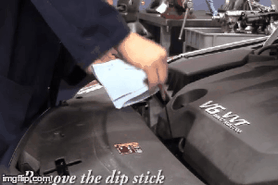
Raise of hands – who breaks out in a cold sweat when their check engine light turns on? (Driving a 2003 vehicle myself, I feel your pain)
Let Josh Graf of JJC’s Automotive program calm your car anxieties with five simple maintenance tips to keep your car on the road and out of the repair shop.

1. Checking your oil
Remove the oil dipstick and wipe it off completely. Once clean, reinsert the stick and remove it again. Hold the handle up, away from the ground. Check the levels at the bottom of the stick. Your oil should be visible between the ‘full’ and ‘low’ marks.
2. Checking your coolant
Do not remove your coolant cap (can become pressurized after driving). Instead, look through the clear reservoir to see where the pink liquid line is. Your coolant level should be between the ‘full cold’ and ‘full hot’ marks on the tank.

3. Checking your washer fluid
Look for the cap with the windshield logo. Open the cap and make sure the fluid is a half an inch from the top of the filler neck.
4. Checking your brake fluid
The brake fluid reservoir is also clear, allowing you to see through it. Locate the minimum and maximum markers on the side of the tank and confirm your fluid level is in between those two lines.

5. Checking your air filter
Remove the engine air filter and using a flashlight, shine a light through the backside of the filter. If you can detect a light shining through the opposite side, your filter is still in good condition. If you can’t see the light through the other side, or the light is dim, your filter is likely becoming clogged.
See below for the full Car Maintenance 101 video.
Did you know...?
The Automotive Service Technology program at JJC is recognized as one of the premier automotive training programs in the Midwest, serving both the degree-seeking students and professional technicians looking to upgrade their skills. All courses are taught by ASE certified instructors with years of practical experience. The core of the program is the live shop operation where the students go to work repairing actual customer vehicles.
